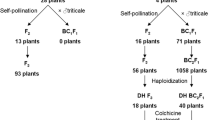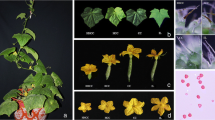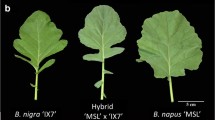Abstract
Introgression of Allium fistulosum into the genome of A. cepa using A. roylei as a bridging species was studied by means of genomic in situ hybridization (GISH). Here we demonstrate for the first time that A. fistulosum can be stably introgressed into A. cepa with a bridge-cross. The first and second bridge-cross generations were fertile, although pollen was sterile in some individuals. Only occasionally were there translocations in the second generation bridge-cross. Recombination between the three genomes was frequently seen in meiotic anaphase 1 and prophase 2 chromosomes of the first generation bridge cross and in mitotic chromosomes of the second generation bridge-cross. The number of observed recombination points in anaphase 1 and prophase 2 significantly exceeded the value expected from chiasma frequency in metaphase 1. Recombination points were randomly distributed, thus the A. cepa or A. roylei type of random distribution prevails over the A. fistulosum type of proximally localised chiasmata.
Similar content being viewed by others
Author information
Authors and Affiliations
Additional information
Received: 15 December 1998 / Accepted: 18 February 1999
Rights and permissions
About this article
Cite this article
Khrustaleva, L., Kik, C. Introgression of Allium fistulosum into A. cepa mediated by A. roylei . Theor Appl Genet 100, 17–26 (2000). https://doi.org/10.1007/s001220050003
Issue Date:
DOI: https://doi.org/10.1007/s001220050003




